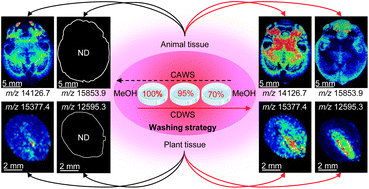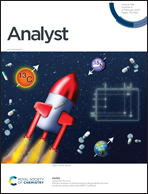A concentration-descending washing strategy with methanol for the enhancement of protein imaging in biological tissues by MALDI-MS†
Abstract
Matrix-assisted laser desorption/ionization mass spectrometry imaging (MALDI-MSI) is a powerful approach that has been widely used for in situ detection of various endogenous compounds in tissues. However, there are still challenges with in situ analysis of proteins using MALDI-MSI due to the ion suppression effects of small molecules in tissue sections. Therefore, tissue-washing steps are crucial for protein MALDI tissue imaging to remove these interfering molecules. Here, we successfully developed a new method named the concentration-descending washing strategy (CDWS) with methanol (MeOH), i.e., washing of biological tissue with 100%, 95%, and 70% MeOH solutions, for the enhancement of endogenous in situ protein detection and imaging in tissues using MALDI-MS. The method of MeOH-based CDWS (MeOH-CDWS) led to the successful in situ detection of 272 ± 3, 185 ± 4, and 134 ± 2 protein ion signals from rat liver, rat brain, and germinating Chinese-yew seed tissue sections, respectively. By comparison, 161 ± 2, 121 ± 1, and 114 ± 2 protein ions were detected by three commonly used methods, i.e., Carnoy's wash, ethanol (EtOH)-based CAWS (i.e., concentration-ascending washing strategy, 70% EtOH followed by 90% EtOH/9% AcOH), and isopropanol (iPrOH)-based CAWS (70% iPrOH followed by 95% iPrOH), respectively, in rat liver tissue sections, indicating that 68.9 ± 3.1%, 124.8 ± 3.3%, and 138.6 ± 4.4% more protein ion signals could be detected by the use of MeOH-CDWS than the three abovementioned washing strategies. Our results show that the use of MeOH-CDWS improves the performance of MALDI-MSI for in situ protein detection such as the number and intensity of proteins. The use of MeOH-CDWS improves the fixation of proteins and thus reduces the loss of proteins, which significantly reduces protein delocalization in tissue and enhances the performance of MALDI tissue imaging of protein. Thus, the use of MeOH-CDWS improves the quality of protein images in tissue sections through MALDI-MSI and has the potential to be used as standard practice for MALDI tissue imaging of proteins.



 Please wait while we load your content...
Please wait while we load your content...